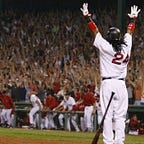Market inefficiencies, an unwillingness to spend, and how Francisco Lindor became a New York Met.
Another day, another generational, homegrown talent traded away. Last year we saw Mookie Betts, the Red Sox’s 5th round pick in the 2011 MLB Draft who turned into a perennial MVP candidate with the team, traded away because the Red Sox wanted to cut salary. Now we see Francisco Lindor, who has been the face of Cleveland’s baseball team since his debut in 2015, traded away to the New York Mets for the same reasons the Red Sox had for trading Mookie Betts: an unwillingness to spend money. In the early 2000s, Oakland Athletics General Manager Billy Beane used sabermetrics to exploit inefficiencies in the market to build a playoff team with less money than any other team in the league, creating a new baseball era. Since the dawn of the “Moneyball” era, teams have been looking at new ways to evaluate players and find the next big star. In this story, I will explore the market inefficiencies that are going on in the MLB, how the Mets exploited them, and why it led to a generational talent in Francisco Lindor being traded away.
On Thursday afternoon, Francisco Lindor and Carlos Carrasco were traded to the New York Mets for Andrez Giminez, Amed Rosario, the Mets #10 prospect, Isaiah Greene, and their #9 prospect, Josh Wolf. A trade that has long been speculated across the league has finally happened. The Mets under their new owner, Steve Cohen, and new GM, Jared Porter, are looking to spend and put a championship team on the field. The most significant holes in the Mets’ lineup are both filled, as they signed catcher James McCann earlier in the offseason, and now they’ve got a shortstop in Francisco Lindor. The Mookie Betts trade that I mentioned earlier is the closest example to the Lindor trade, as neither makes much sense. The Red Sox going into last season before they traded Betts were a fringe playoff team, and they likely should have gone after more pieces to try and bring them over the edge, but instead, they decided to cut their payroll and trade Betts. The Indians were a playoff team in 2020 and could have continued on that course in 2021 if Lindor had not been traded. These two trades have shown a considerable inefficiency in the baseball market, and the Mets exploited it.
The most significant market inefficiency in baseball right now, as simple as it may sound, is to spend money on improving your team. The Mookie Betts and Francisco Lindor trades don’t make sense from an analytical standpoint, as the Red Sox and Indians will both lose more games without them than they would with them. Still, teams think that because they found Betts or Lindor, they can find and develop players like that every year, but that isn’t true. Generational talent is tough to come by; some names that come to mind include Mike Trout, Lebron James, Patrick Mahomes, and Lindor and Betts. Talent like that doesn’t just come through the door every day, and when players like that do come around, teams should pay them to stay with their organization, not trade them away to avoid paying their contract.
Since his debut in 2015, Lindor’s 28.9 FWAR is the fifth most in the entire league, and his 258 extra-base hits since 2017 are the third most in that span. Lindor has amassed a .285/.346/.488 slash line and a .833 OPS in his career thus far to go along with 138 home runs. Lindor also finished in the top 10 in Defensive WAR in 2018 and 2019 and is 23rd on the active leaderboard in that category. Lindor plays one of the most challenging positions in baseball, and what makes a good shortstop can’t always be seen with the naked eye. Shortstop requires a lot of range and speed as you have to move quickly to both your left and right, and the best shortstops like Andrelton Simmons and Lindor make it look so easy that you don’t even notice how good they are. Since 2015, Lindor is 14th in the league in Defensive Runs Saved, a stat defined as “quantifies a player’s entire defensive performance by attempting to measure how many runs a defender saved. It takes into account errors, range, outfield arm, and double-play ability.”
Francisco Lindor is one of the best shortstops in the entire league and one of the best players in baseball, and the team that signed and developed him decided that they did not want to pay him what he was worth for reasons I’m not sure of. The Mets swooped in and exploited the most prominent market inefficiency in all of baseball, and their team got astronomically better in doing so. That’s Moneyball; that’s what Billy Beane was doing in the Athletics front office. Beane was finding inefficiencies and taking advantage of them. The difference is that the inefficiencies he saw were for cheap, undervalued players; the Mets and Jared Porter did the same thing but with an undervalued expensive player. The Mets are set up well for their future, with a powerful starting rotation and a lineup that just added one of the best players in baseball.
